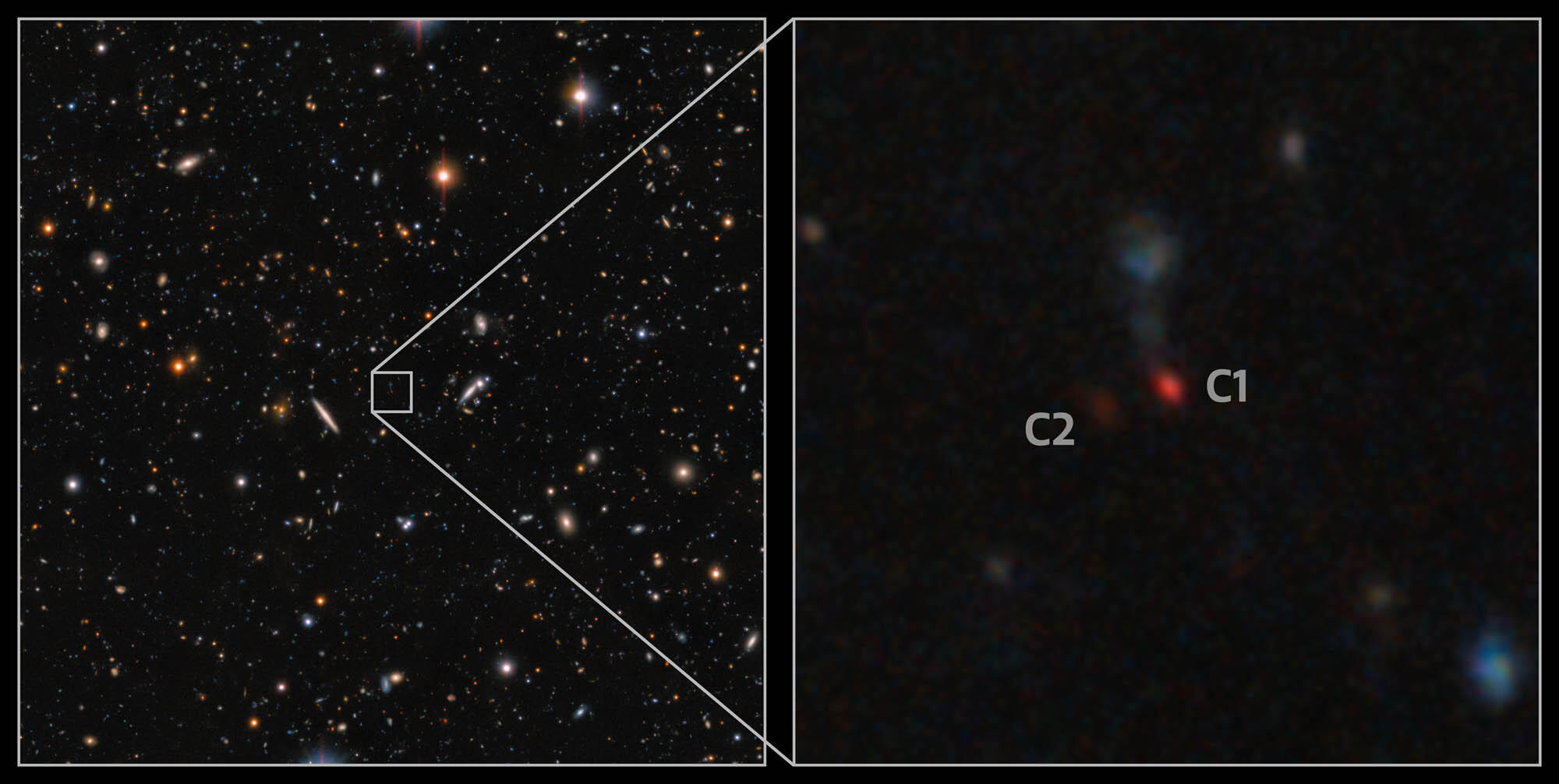A team of astronomers, including ICREA-ICCUB researcher Kazushi Iwasawa, have discovered a pair of merging quasars seen only 900 million years after the Big Bang. Not only is this the most distant pair of merging quasars ever found, but also the first confirmed pair in the period of the Universe’s history known as Cosmic Dawn.
Since the very first instant after the Big Bang the Universe has been expanding. This means that the early Universe was considerably smaller and early-formed galaxies were more likely to interact and merge. Galaxy mergers fuel the formation of quasars — extremely luminous galactic cores where gas and dust falling into a central supermassive black hole emit enormous amounts of light. So when looking back at the early Universe astronomers would expect to find numerous pairs of quasars in close proximity to each other as their host galaxies undergo mergers. However, they have been surprised to find exactly none — until now.
“This is the first quasar pair found in the early Universe”, says Dr Iwasawa, one of the core members of the SEHLLQs collaboration searching for low luminosity quasars at high redshift. “It means that the black holes in both galaxies are activated. It took a high-sensitivity and wide area survey like the HSC survey for this discovery. It is also worth noting that, although they are both low-luminosity quasars as observed, this system is expected to evolve into a very powerful quasar later when their black holes finally merge”.
Cosmic Dawn spanned from about 50 million years to one billion years after the Big Bang. During this period the first stars and galaxies began appearing, filling the dark Universe with light for the first time. The arrival of the first stars and galaxies kicked off a new era in the formation of the cosmos known as the Epoch of Reionization.
The Epoch of Reionization, which took place within Cosmic Dawn, was a period of cosmological transition. Beginning roughly 400 million years after the Big Bang, ultraviolet light from the first stars, galaxies and quasars spread throughout the cosmos, interacting with the intergalactic medium and stripping the Universe’s primordial hydrogen atoms of their electrons in a process known as ionization. The Epoch of Reionization was a critical epoch in the history of the Universe that marked the end of the cosmic dark ages and seeded the large structures we observe in our local Universe today.
To understand the exact role that quasars played during the Epoch of Reionization, astronomers are interested in finding and studying quasars populating this early and distant era. “The statistical properties of quasars in the Epoch of Reionization tell us many things, such as the progress and origin of the reionization, the formation of supermassive black holes during Cosmic Dawn, and the earliest evolution of the quasar host galaxies,” said Yoshiki Matsuoka, an astronomer at Ehime University in Japan and lead author of the paper describing these results, published in the Astrophysical Journal Letters.
About 300 quasars have been discovered in the Epoch of Reionization, but none of them have been found in a pair. That is until Matsuoka and their team were reviewing images taken with the Hyper Suprime-Cam on the Subaru Telescope and a faint patch of red caught their eye. “While screening images of quasar candidates I noticed two similarly and extremely red sources next to each other,” said Matsuoka. “The discovery was purely serendipitous.”

The team was not sure that they were a quasar pair since distant quasar candidates are contaminated by numerous other sources, such as foreground stars and galaxies and the effects of gravitational lensing. To confirm the nature of these objects the team conducted follow-up spectroscopy using the Faint Object Camera and Spectrograph (FOCAS) on the Subaru Telescope and the Gemini Near-Infrared Spectrograph (GNIRS) on Gemini North. The spectra, which break down the emitted light from a source into its component wavelengths, obtained with GNIRS were crucial to characterizing the nature of the quasar pair and their host galaxies.
“What we learned from the GNIRS observations was that the quasars are too faint to detect in near-infrared, even with one of the largest telescopes on the ground,” said Matsuoka. This allowed the team to estimate that a portion of the light detected in the optical wavelength range is not coming from the quasars themselves, but from ongoing star formation taking place in their host galaxies. The team also found that the two black holes are whoppers, each being 100 million times the mass of the Sun. This, coupled with the presence of a bridge of gas stretching between the two quasars, suggests that they and their host galaxies are undergoing a major-scale merger.
“The existence of merging quasars in the Epoch of Reionization has been anticipated for a long time. It has now been confirmed for the first time,” said Matsuoka.
The Epoch of Reionization connects the earliest formation of cosmic structure to the complex Universe that we observe billions of years later. By studying distant objects from this period astronomers gain valuable insight into the process of reionization and the formation of the first objects in the Universe. More discoveries like this may be on the horizon with NSF–DOE Vera C. Rubin Observatory’s decade-long Legacy Survey of Space and Time (LSST), beginning in 2025, which is poised to detect millions of quasars using its deep imaging capabilities.
More information
This research was presented in a paper entitled “Discovery of Merging Twin Quasars at z = 6.05” to appear in the Astrophysical Journal Letters. DOI: 10.3847/2041-8213/ad35c7
The team is composed of Yoshiki Matsuoka (Ehime University, Japan), Takuma Izumi (National Astronomical Observatory of Japan, Tokyo), Masafusa Onoue (Kavli Institute for the Physics and Mathematics of the Universe, Japan), Michael A. Strauss (Princeton University, USA), Kazushi Iwasawa (Universitat de Barcelona Spain), Nobunari Kashikawa (University of Tokyo, Japan), Masayuki Akiyama (Tohoku University, Japan), Kentaro Aoki (Subaru Telescope, National Astronomical Observatory of Japan, USA), Junya Arita (University of Tokyo, Japan), Masatoshi Imanishi (National Astronomical Observatory of Japan, Graduate University for Advanced Studies [SOKENDAI], Japan), Rikako Ishimoto (University of Tokyo, Japan), Toshihiro Kawaguchi (Onomichi City University, Japan), Kotaro Kohno (University of Tokyo, Japan), Chien-Hsiu Lee (W. M. Keck Observatory, USA), Tohru Nagao (Ehime University, Japan), John D. Silverman (Kavli Institute for the Physics and Mathematics of the Universe, Japan), and Yoshiki Toba (Ehime University, Japan, National Astronomical Observatory of Japan, Tokyo, Academia Sinica Institute of Astronomy and Astrophysics, Taiwan).



